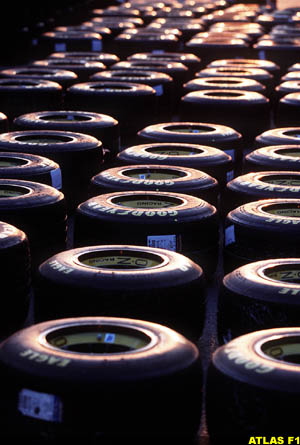 |
All Tired Out |
| by Robert Butsch, U.S.A. | |
|
Everyone is worried about how aerodynamics and horsepower affect performance. But neither of these factors have much effect if you don't have good tires. Robert Butsch looks at why Formula One may be better off as a single tyre spec formula
Brian Ward wrote an article recently that indirectly pointed this out. Ward proposed an interesting thought experiment. What would it be like if all the fantastic technology in Formula One that has over the years been banned from the sport - ground effects, fan cars, active suspension, anti-lock braking systems, traction control, turbocharged engines - had been left in place? What kind of cars would turn up on the grid today? Ward suggested very dangerous ones. One might also add incredibly expensive ones.
Ward's speculation is intriguing and, like all good thought experiments, ultimately revealing. I tried to picture the sort of screaming, sucked-down, umpteen-g monsters that would be found turning sub-one minute laps at, say, Interlagos under his hypothetical scenario. However, after a bit of consideration it dawned on me that there would be none. Why? It would probably be impossible for anyone to come up with a tire, that indispensable round inconvenience, that could keep such a vehicle on the track. Even turns with radii that a super tanker could negotiate would see these cars off in the gravel. And if by some miraculous leap in technology it was indeed possible, any such super-gluey tire could have no practical life span. Pre-race speculation would run along the lines of whether so-and-so is planning a ten or eleven stop strategy.
Understanding this leads one to a new appreciation of just how big a favor our physics teachers did us when they introduced us to the simple idea of coefficient of friction. Current Formula One philosophical discourse divides "grip" into aerodynamic and mechanical categories. But we should realize, just as does any average motorist finding themself standing on the brake pedal in order to avoid some idiot who's run a stop light, that it all boils down to how well the tires are going to stick to the road. The aerodynamic vs. mechanical distinction can be a misleading one. It doesn't matter how much (or, for that matter, little) downforce is present if the tires can't turn it into grip.
This may have been on the FIA rule-makers' minds in 1997 when they mandated grooved tires instead of big changes in aerodynamic appendages in an effort to slow the cars down. Hindsight and honesty force us to admit that taking relatively small amounts of surface area out of Formula One tires has produced significant results, as evidenced by lap times that have remained more or less constant in spite of large improvements in engines and aerodynamics.
However, this was anything but clear in 1997. Max Mosley in his role as FIA president was perhaps expected to defend the grooved tire decision, but his obvious enthusiasm for it left many questioning his judgment. Max took a lot of heat, some of it from a few of the pilotes audacieux who were going to have to bet their flesh and blood on the new mixture of phenomenal engines, suspensions, and chassis riding on pretty unphenomenal tires. I must confess that I was an early passenger on the "no, you're wrong, Max," bandwagon. If you rifle AtlasF1's archives you might find the letter I wrote decrying the advent of the new tires. I won't embarrass myself here by recounting all of my arguments against them that proved groundless.
|
||||
|
In this context the return of Michelin to Formula One next year should be of concern to Max and the FIA. Grooves have worked only because Bridgestone's tire alchemists have had no motivation to do end runs around them with exotic new compounds. But Bridgestone are in Formula One to make Bridgestone look good, and that may not happen over the next few years unless they produce faster tires than Michelin. "Race Car" magazine last year quoted Bridgestone's UK technical manager, Yoshihiko Ichikawa, thusly:
"The FIA asked us to slow the cars, so we have harder rubber than otherwise might have been the case. This has been made possible because we are the only supplier. If there was another company involved, and we had to compete with them, this would not be possible." Michelin's thinking will be running in a similar vein. Competition could raise the Formula One tire from its present reduced circumstances back to the, if not exalted at least semi-sexy, status it enjoyed in the '70s, '80s and early '90s, in the process possibly undoing any good that grooves seem to have provided. All things (especially safety) considered, perhaps it would be best for the FIA to declare these lowly rubber doughnuts too important to allow anything but strict control over them, and to consider contracting with a single tire maker to provide spec tires (even, dare I mention it, Max's newest idea: all-weather tires) to all of the teams. Then let the aerodynamicists and engine designers loose to wreak what havoc they may. If they go over the top, change the tire specification. Formula 1 could then retain its biggest claim to fame over other versions of motor sport; to wit, absolute cutting edge technology. Except, of course, in tires. |
A Tyre for all Seasons
The Case for Slicks
The Case for Grooves
Slicks, Definitely Slicks
Mosley's Equation
How the Sport can Regain its Winning Formula
The Ultimate Grand Prix Car |
|||
| Robert Butsch | © 2000 Kaizar.Com, Incorporated. |
| Send comments to: schond@onlinetoday.com | Terms & Conditions |
